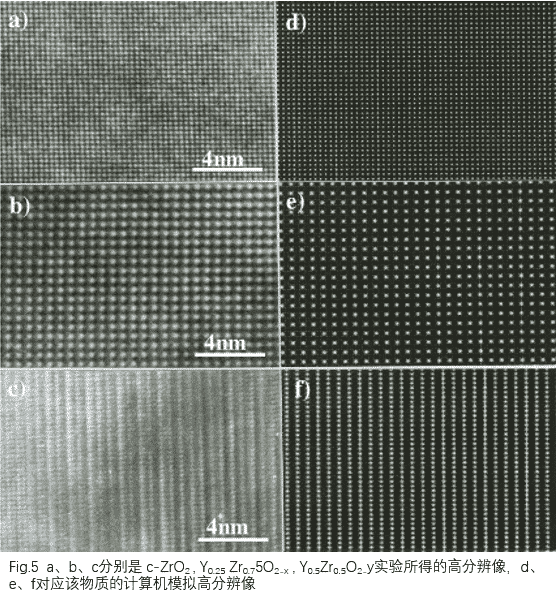High resolution transmission electron microscopy (HRTEM or HREM) is the phase contrast (the contrast of high-resolution electron microscopy images is formed by the phase difference between the synthesized projected wave and the diffracted wave, It is called phase contrast.) Microscopy, which gives an atomic arrangement of most crystalline materials.
High-resolution transmission electron microscopy began in the 1950s. In 1956, JWMenter directly observed parallel strips of 12 ? copper phthalocyanine with a resolution of 8 ? transmission electron microscope, and opened high-resolution electron microscopy. The door to surgery. In the early 1970s, in 1971, Iijima Chengman used a TEM with a resolution of 3.5 ? to capture the phase contrast image of Ti2Nb10O29, and directly observed the projection of the atomic group along the incident electron beam. At the same time, the research on high resolution image imaging theory and analysis technology has also made important progress. In the 1970s and 1980s, the electron microscope technology was continuously improved, and the resolution was greatly improved. Generally, the large TEM has been able to guarantee a crystal resolution of 1.44 ? and a dot resolution of 2 to 3 ?. HRTEM can not only observe the lattice fringe image reflecting the interplanar spacing, but also observe the structural image of the arrangement of atoms or groups in the reaction crystal structure. Recently, Professor David A. Muller’s team at Cornell University in the United States used laminated imaging technology and an independently developed electron microscope pixel array detector to achieve a spatial resolution of 0.39 ? under low electron beam energy imaging conditions.
Currently, transmission electron microscopes are generally capable of performing HRTEM. These transmission electron microscopes are classified into two types: high resolution and analytical. The high-resolution TEM is equipped with a high-resolution objective pole piece and a diaphragm combination, which makes the sample table tilt angle small, resulting in a smaller objective spherical aberration coefficient; while the analytical TEM requires a larger amount for various analyses. The tilt angle of the sample stage, so the objective lens pole shoe is used differently than the high resolution type, thus affecting the resolution. In general, a 200 kev high resolution TEM has a resolution of 1.9 ?, while a 200 kev analytical TEM has a 2.3 ?. But this does not affect the analytical TEM shooting high resolution image.
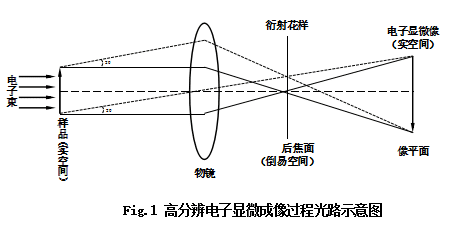
As shown in Fig. 1, the optical path diagram of the high-resolution electron microscopy imaging process, when an electron beam with a certain wavelength (λ) is incident on a crystal with a crystal plane spacing d, the Bragg condition (2dsin θ = λ) is satisfied, A diffracted wave is generated at an angle (2θ). This diffracted wave converges on the back focal plane of the objective lens to form a diffraction spot (in an electron microscope, a regular diffraction spot formed on the back focal plane is projected onto the phosphor screen, which is a so-called electron diffraction pattern). When the diffracted wave on the back focal plane continues to move forward, the diffracted wave is synthesized, an enlarged image (electron microscopic image) is formed on the image plane, and two or more large objective lens stops can be inserted on the back focal plane. Wave interference imaging, called high-resolution electron microscopy, is called a high-resolution electron microscopic image (high-resolution microscopic image).
As mentioned above, the high-resolution electron microscopic image is a phase contrast microscopic image formed by passing the transmitted beam of the focal plane of the objective lens and the several diffracted beams through the objective pupil, due to their phase coherence. Due to the difference in the number of diffracted beams participating in imaging, high resolution images of different names are obtained. Due to the different diffraction conditions and sample thickness, high-resolution electron micrographs with different structural information can be divided into five categories: lattice fringes, one-dimensional structural images, two-dimensional lattice images (single-cell images) , two-dimensional structure image (atomic scale image: crystal structure image), special image.
Lattice fringes: If a transmission beam on the back focal plane is selected by the objective lens, and a diffraction beam interferes with each other, a one-dimensional fringe pattern with a periodic change in intensity is obtained (as shown by the black triangle in Fig. 2 (f)) This is the difference between a lattice fringe and a lattice image and a structural image, which does not require the electron beam to be exactly parallel to the lattice plane. Actually, in observation of crystallites, precipitates, and the like, lattice fringes are often obtained by interference between a projection wave and a diffraction wave. If an electron diffraction pattern of a substance such as crystallites is photographed, a ring of worship will appear as shown in (a) of Fig. 2.
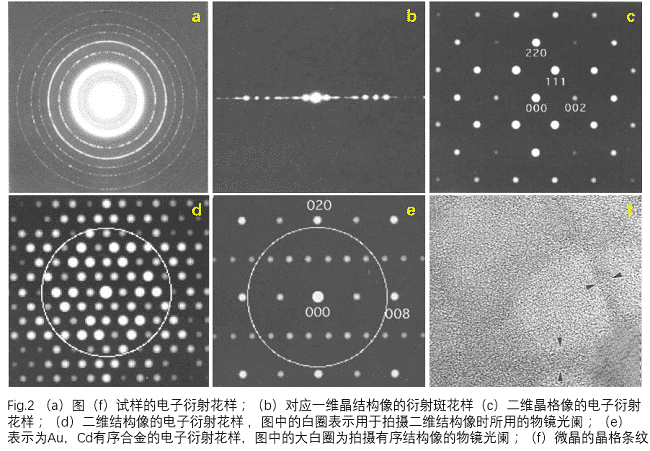
One-dimensional structure image: If the sample has a certain tilt, so that the electron beam is incident parallel to a certain crystal plane of the crystal, it can satisfy the one-dimensional diffraction diffraction pattern shown in Fig. 2(b) (symmetric distribution with respect to the transmission spot) Diffraction pattern). In this diffraction pattern, the high resolution image taken under the optimal focus condition is different from the lattice fringe, and the one-dimensional structure image contains the information of the crystal structure, that is, the obtained one-dimensional structure image, as shown in Fig. 3 (a A high resolution one-dimensional structural image of the Bi-based superconducting oxide shown.
Two-dimensional lattice image: If the electron beam is incident parallel to a certain crystal axis, a two-dimensional diffraction pattern can be obtained (two-dimensional symmetric distribution with respect to the central transmission spot, shown in Fig. 2(c)). For such an electron diffraction pattern. In the vicinity of the transmission spot, a diffraction wave reflecting the crystal unit cell appears. In the two-dimensional image generated by the interference between the diffracted wave and the transmitted wave, a two-dimensional lattice image showing the unit cell can be observed, and this image contains information on the unit cell scale. However, information that does not contain an atomic scale (into atomic arrangement), that is, a two-dimensional lattice image is a two-dimensional lattice image of single crystal silicon as shown in Fig. 3(d).
Two-dimensional structure image: a diffraction pattern as shown in Fig. 2(d) is obtained. When a high-resolution electron microscope image is observed with such a diffraction pattern, the more diffraction waves involved in imaging, the information contained in the high-resolution image is also The more. A high-resolution two-dimensional structure image of the Tl2Ba2CuO6 superconducting oxide is shown in Fig. 3(e). However, the diffraction of the high-wavelength side with higher resolution limit of the electron microscope is unlikely to participate in the imaging of the correct structure information, and becomes the background. Therefore, within the range allowed by the resolution. By imaging with as many diffracted waves as possible, it is possible to obtain an image containing the correct information of the arrangement of atoms within the unit cell. The structure image can only be observed in a thin region excited by the proportional relationship between the wave participating in imaging and the thickness of the sample.
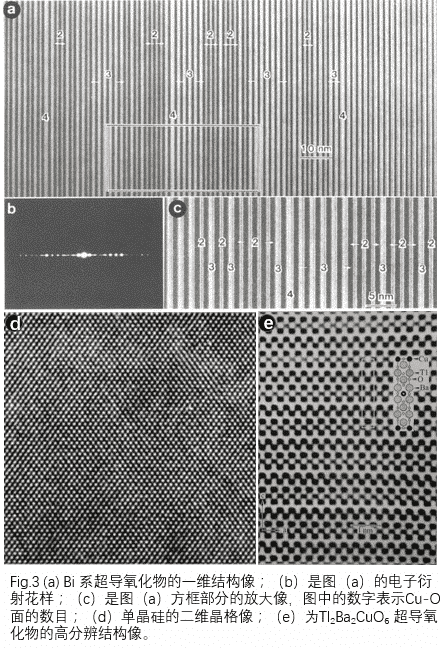
Special image: On the diffraction pattern of the back focal plane, the insertion of the aperture only selects the specific wave imaging to be able to observe the image of the contrast of the specific structural information. A typical example of it is an ordered structure like. The corresponding electron diffraction pattern is shown in Fig. 2(e) as the electron diffraction pattern of the Au, Cd ordered alloy. The ordered structure is based on a face-centered cubic structure in which Cd atoms are arranged in order. Fig. 2(e) electron diffraction patterns are weak except for the basic lattice reflections of the indices (020) and (008). Ordered lattice reflection, using the objective lens to extract the basic lattice reflection, using transmission waves and ordered lattice reflection imaging, only Cd atoms with bright points or dark points such as high resolution as shown in Fig. 4.
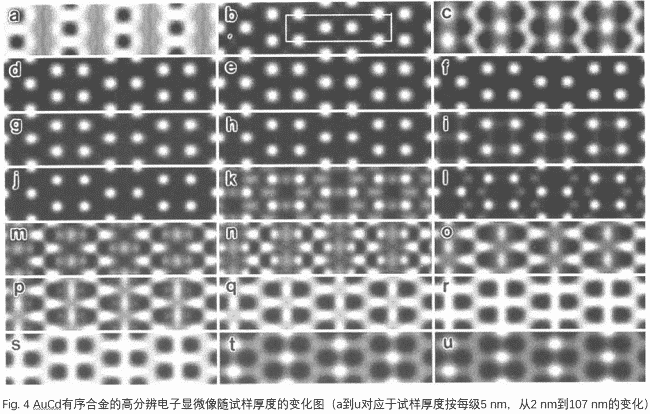
As shown in Fig. 4, the high resolution image shown varies with the thickness of the sample near the optimum high resolution underfocus. Therefore, when we get a high-resolution image, we can’t simply say what the high-resolution image is. We must first do a computer simulation to calculate the structure of the material under different thicknesses. A high resolution image of the substance. A series of high-resolution images calculated by the computer are compared with the high-resolution images obtained by the experiment to determine the high-resolution images obtained by the experiment. The computer simulation image shown in Fig. 5 is compared with the high resolution image obtained by the experiment.
